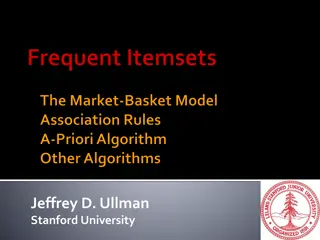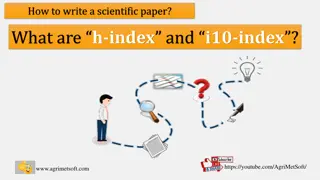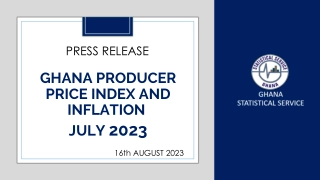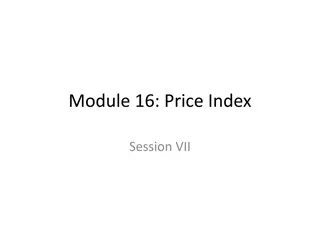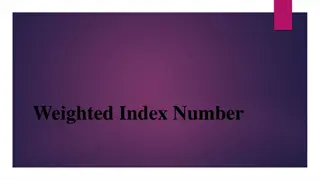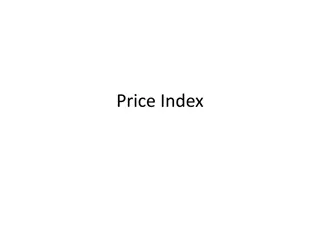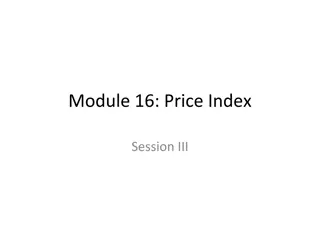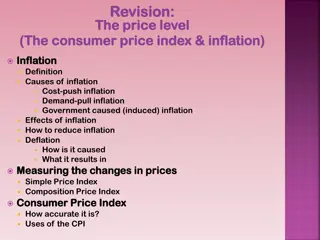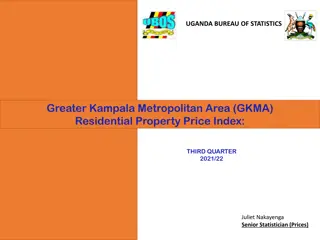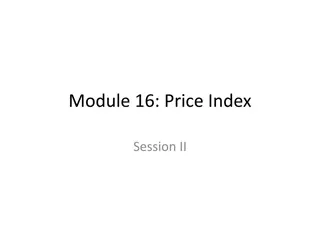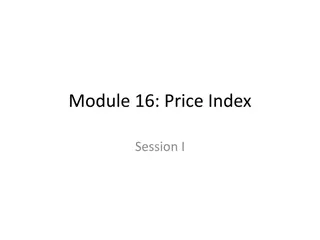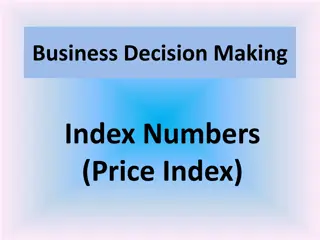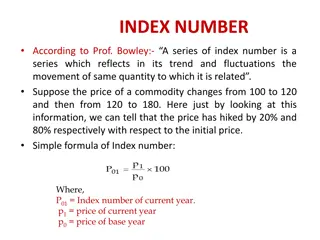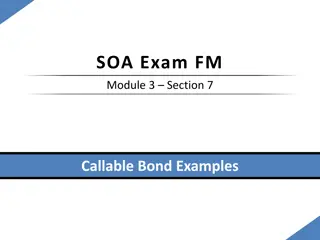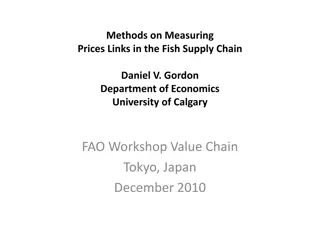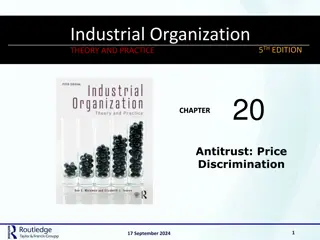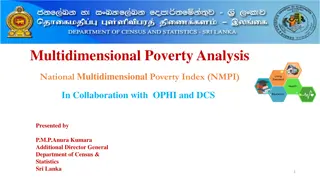Understanding the Structure of Price Index Baskets
Explore the construction and composition of price index baskets, including how goods and services are selected, classified, and weighted to compile a price index. Learn about hierarchical structures, product classifications, and decision-making processes involved in creating these essential tools for economic analysis.
Download Presentation

Please find below an Image/Link to download the presentation.
The content on the website is provided AS IS for your information and personal use only. It may not be sold, licensed, or shared on other websites without obtaining consent from the author. Download presentation by click this link. If you encounter any issues during the download, it is possible that the publisher has removed the file from their server.
E N D
Presentation Transcript
Price Index Session VI
Module 16: Price Index Session VI
Contents Session VI Construction of Price Index Part III Basket and its structure use of standard classifications Weighting structure source of data price and other updating of weights Classifications 3
Basket and its Structure Basket The term basket is commonly used for the list of goods and services, for which a sample of prices is collected for compiling a price index. Usually the basket also includes relative share in terms of value of the goods & services, serving as weights. It may also consist of specific quantities of goods and services, instead of values.
Basket and its Structure Composition of Basket Decisions on the composition of the basket and the weights follow directly from the scope and coverage of the index. The goods and services within the scope of an index are invariably very large in number. The quantity / value data (for determining weights) are collected separately for item-groups rather than for individual items Price data are collected for selected items of an item- This selection of items constitutes the basket.
Basket and its Structure Hierarchical structure in a Basket (1) The goods and services included in the basket are usually arranged in a hierarchical structure, using standard classifications. The individual products of the basket called items are kept at the lowest level of the hierarchy. The prices are actually collected for the basket items. These are grouped into sub-classes, classes and groups following standard classifications.
Basket and its Structure Hierarchical structure in a Basket (2) The sub-classes (also called product headings ) are the most detailed level (i.e. lowest level) of these classifications. Normally, the sub-classes are the elementary aggregates used for compilation of the index It is the lowest level at which index weights are attached.
Basket and its Structure Product Classification Basket items [individual products for which prices are collected] combined to form Product sub-class [intended to be homogenous w.r.t.: purpose prices level and trend substitutability ]
Basket and its Structure Homogeneity Purpose. The products withinan item-group should have a broadly similar purpose - using COICOP (which is a purpose classification) should assist in ensuring this. Prices. Products should be selected in such a way that the price movements (and to a lesser extent price levels) are likely to be reasonably similar. Substitutability. The choice of products to include within an Item-group should be to a certain degree substitutable in response to a change in relative prices.
Basket and its Structure Elementary Aggregate The smallest aggregate for which reliable quantity / value data are normally available and used for Price Index calculation to compute an elementary price index. The quantity / value associated with the elementary aggregates are used to weight the elementary price indices to obtain higher level indices.
Basket and its Structure Example 21: Selecting basket items in an elementary aggregate Suppose there are 7 brands of body soap available in the market. Of these A, B & C are low priced with about 70 per cent market share. D, E & F similar in quality with about 20 per cent share. G a high-priced imported variety with high price fluctuations. Which of these should be included in the basket?
Weighting Structure source of data, price and other updating of weights
Weights Aggregation procedure
Constructing Price Index - Weights System of Allocation of Weights In the construction of index numbers all commodities included are not of equal importance. The system of allocation of weights to different items is, therefore, of utmost importance. The weights may be assigned to the various commodities in according to their economic importance. 15
Constructing Price Index - Weights System of Allocation of Weights (2) Weighting is a top-down process. The total is divided between the highest-level headings of the classification system. The weight of a highest-level heading is then divided between the classes. The weight of each class is divided between its sub-classes. Lastly, weight of a sub-class is allocated to its elementary aggregate. 16
Constructing Price Index - Weights Allocation of Weights An Example Overall Index: 1000 Major Head - A: 300 Major Head - B: 230 Major Head - C: 250 Major Head - D: 220 to classes sub-classes elementary aggregates (EA) to classes sub-classes elementary aggregates to classes sub-classes elementary aggregates to classes sub-classes elementary aggregates EA-C1: 80 EA-C1: 30 EA-C1: 37 EA-C1: 13 EA-C1: 40 EA-C1: 20 EA-C1: 30 e l e m e n t a r y a g g r e g a t e s o f M a j o r H e a d C 17
Weights Weights for Price Index Compilation Weights used for deriving elementary aggregates from the raw price data are either equal or based on basic sampling method for selecting outlets / production unit. Weights of elementary aggregates used for higher levels of aggregation are usually drawn other sources, such as For CPI: Household consumption expenditure surveys For PPI: National accounts / Structural Business Statistics database For XMPI: Export-Import statistics Most often, the weights are expressed in parts of 1000.
Weights Weighting Structure The weighting structure should follow the aggregation structure. Each sub-class is assigned a weight. For each sub-class, the weights are then distributed over the elementary groups falling in it. The weight of an elementary aggregate represents the entire elementary aggregate and not just the weights of the items that have been chosen to represent it in price collection survey.
Weights Weights within Elementary Aggregates Often, the elementary aggregate is the lowest level at which reliable weighting information is available. Thus, the price indices for elementary aggregates are calculated without the use of explicit weights as unweighted averages. Ideally, however, weights even if approximate should be used to reflect the relative importance of the sampled items. For example, when the items are selected with PPS with size as, say, sales, value of output etc., weights are implicitly introduced by the sampling selection procedure.
Weights Weights within Elementary Aggregates Often, the elementary aggregate is the lowest level at which reliable weighting information is available. Thus, the price indices for elementary aggregates are calculated without the use of explicit weights as unweighted averages. Ideally, however, weights even if approximate should be used to reflect the relative importance of the sampled items. For example, when the items are selected with PPS with size as, say, sales, value of output etc., weights are implicitly introduced by the sampling selection procedure.
Weights Price and other updating of weights Mainly, the following kinds of updating of weights are adopted by the statistical offices: Price updating of weights Introduction/ removal of new/ old products Weights updating without changing the set of products.
Weights Price and other updating of weights Mainly, the following kinds of updating of weights are adopted by the statistical offices: Price updating of weights Introduction/ removal of new/ old products Weights updating without changing the set of products.
Weights Price updating of weights Already discussed in Session II. It is recalculating the weights from the values obtained by applying prices of a different period on the quantities of the weight reference period. The values of products thus obtained are used for deriving their respective weights. This kind of updating is essential when the relative prices of the goods and services in the coverage of the index change rapidly. No change is required to be made in the lists of products and reporting units.
Weights Introduction/ removal of new/ old products This kind of re-weighting involves drawing a new sample of products and a new list of reporting units and a chained index is the result. This brings about changes in the compositions of elementary aggregates but need not necessarily involve change in weighting pattern for aggregation at higher levels. The new values of the index should be re-referenced to the index reference period to provide a continuous time series.
Weights Weights updating without changing set of products This involves annual updating of the product weights. The indices are annually chained weight reference period of the previous year while the index reference period (set to 100) remains unchanged.
Classification Role of Product Classification A Price Index is compiled in stages. First, elementary price indices are calculated, which are then aggregated to higher-level price index. Product classification follows the aggregation structure. Since, Price Index is compiled from data on prices and quantity / value weights, both the data collection systems should follow the same classification of products
Classification Commonly-used Classifications for Price Index For CPI: (COICOP) or Central Product Classification (CPC) For PPI: Central Product Classification (CPC) or International Standard Industrial Classification of All Economic Activities (ISIC) For XMPI: Standard International Trade Classification
Classification COICOP Useful for identifying and classifying individual consumption expenditures incurred by households according to the purposes, or objectives. Driven by a functional principle rather than a market grouping principle. For example, insurance on cars is included under transport rather than in the insurance item Useful in grouping product price data for the purpose of CPI. Web reference: http://unstats.un.org/unsd/class/default.asp
Classification ISIC 4.0 ISIC - A coherent and consistent classification structure of economic activities. ISIC is a standard classification of productive activities production of goods and services Economic activities are subdivided in a hierarchical, four- level structure of mutually exclusive categories: section, division, group and class. Web reference: http://unstats.un.org/unsd/class/default.asp
Classification Central Product Classification (CPC), Ver 2: Provides a framework for classifying all goods and services. Serves as a guide for developing or revising classification schemes of products Designed to be integrated and corresponded to ISIC, but with CPC itself, one cannot tell which industries produce the products. Useful for identifying product type by originating activity. Web reference: http://unstats.un.org/unsd/class/default.asp Oct. 2013 SIAP-ICPOS1 32



